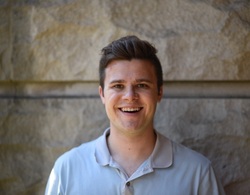8/30/2024 Brock Carlson: Stimulus and State Dependent Differences in V1 Laminar Coherence
Neuroscience Brown Bag

Brock Carlson
Graduate Student
Maier Lab
Date: Friday, August 30, 2024
Time: 1:25PM-2:15PM
Location: 316 Wilson Hall
Stimulus and State Dependent Differences in V1 Laminar Coherence
Stimulus aftereffects from subjects who divert attention away from binocular rivalry reveal a unique mode of vision where interocular fusion does not occur; instead, both eyes’ inputs receive equal processing (Qian et al., 2019). Similarly, rivalry-induced traveling waves are observable in V1 with fMRI but not in higher visual areas when attention is diverted (Lee et al., 2007). Additionally, adaptation-dependent differences in V1 neuronal activity during binocular rivalry flash suppression (BRFS) are preserved even under anesthesia (Bahmani et al., 2014). This evidence suggests that V1 has an automatic, reflex-like mechanism for processing conflicts between the eyes. Our study aims to understand how interocular conflict is computed within the V1 microcircuit by utilizing laminar coherence. We hypothesized that a decrease in laminar coherence would occur with dichoptic stimulation. This technique is of particular interest because it simultaneously compares all electrode pairs on our 32-channel laminar microelectrodes, providing a structural abstraction of the cortical column’s state for any given trial. A null hypothesis was also considered, proposing that no differences would be observed between trial types, as coherence has previously been reported as a stable metric of laminar position, regardless of visual stimulation (Maier et al., 2010).
Dichoptic stimulation resulted in lower laminar coherence than dioptic stimulation. We also compared BRFS trial types, where the physically identical stimulus was shown to the subject, but a different period of monocular adaptation had occurred. A similar decrease in coherence was observed during preferred stimulus suppression as with dichoptic stimulation. The decrease in coherence between BRFS trial types was surprising because interocular conflict was identical between stimuli. In both cases, the decrease in coherence occurred between the deep to the upper layers. Our results suggest that the V1 microcircuit may automatically initiate eye-based suppression through the timing of neuronal activity rather than a rate-code.
Questions? Contact Jon Kaas